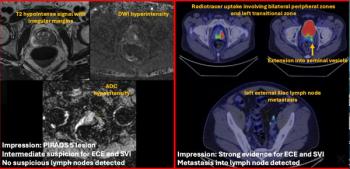
Could AI Enhance Early Detection of COVID-19 on Chest X-Rays?
Preliminary research revealed an area under the curve (AUC) of 85 percent for an artificial intelligence (AI) algorithm in diagnosing COVID-19 on initial chest X-rays in comparison to a consensus 71 percent AUC for five radiologists.
While reverse transcription-polymerase chain reaction (RT-PCR) testing is considered the standard for the diagnosis of COVID-19, an emerging artificial intelligence (AI) algorithm may enhance early diagnosis of the disease on initial chest radiography screening.
In a recent retrospective study published in
In the testing of the algorithm with a subset of initial X-ray images for 225 patients who tested positive for COVID-19 and 255 patients who tested negative for the disease, the study authors found that the algorithm had an area under the curve (AUC) of 85 percent versus a 71 percent AUC for a consensus of five radiologists with experience ranging between 1 to 14 years.
Acknowledging the algorithm’s lower sensitivity for diagnosing COVID-19 in comparison to similar algorithms from other studies, the study authors said the focus of their research was the initial X-ray screening “when pulmonary findings are less conspicuous” than more advanced stages of COVID-19. The researchers said this focus is more conducive to real-world applications involving early diagnosis to facilitate effective triage and timely treatment intervention.
“The advantage of AI may lie in its ability to identify changes in medical images before they become visible to the human eye. That would be the case with COVID-19 patients before abnormal lung densities were conspicuous in (chest X-rays),” wrote study co-author Juan I. Rayo Madrid, MD, who is affiliated with the Department of Nuclear Medicine at Complejo Hospitalario Universitario de Badajoz in Badajoz, Spain, and colleagues.
While recognizing that the predictive power of initial X-ray screening is not optimal for diagnosis of COVID-19, the study authors noted that the modality is inexpensive and widely available. These attributes could make the combination of the AI algorithm and initial X-rays beneficial in limited resource environments where RT-PCR testing results are delayed or unavailable, according to Madrid and colleagues.
“Applying this tool systematically to all (chest X-rays) performed in any health center would allow detection of the disease early without other tests,” noted the study authors.
Madrid and colleagues also suggested that the combination of chest X-rays with adjunctive AI may be more beneficial than RT-PCR testing for ongoing monitoring of lung involvement in patients diagnosed with emerging variants of COVID-19.
“We have experienced continuous outbreaks of new variants whose severity, infectious potential, and symptoms are initially uncertain and need to be intensively investigated for weeks or months. In this context, the RT-PCR test may be less sensitive,” said Madrid and colleagues.
In regard to study limitations, Madrid and coauthors noted the AI algorithm software was trained and tested in the same centers. They acknowledged a lack of information on symptoms, signs and additional tests ordered for patients suspected of having COVID-19. The study also did not examine the potential contribution of the AI algorithm software to radiologist assessment in clinical practice, according to Madrid and colleagues.
Newsletter
Stay at the forefront of radiology with the Diagnostic Imaging newsletter, delivering the latest news, clinical insights, and imaging advancements for today’s radiologists.




























